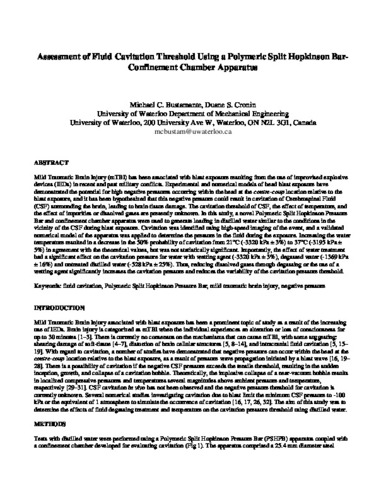| dc.contributor.author | Bustamante, Michael | |
| dc.contributor.author | Cronin, Duane | |
| dc.date.accessioned | 2024-04-05 14:29:30 (GMT) | |
| dc.date.available | 2024-04-05 14:29:30 (GMT) | |
| dc.date.issued | 2018-10-02 | |
| dc.identifier.uri | https://doi.org/10.1007/978-3-319-95062-4_21 | |
| dc.identifier.uri | http://hdl.handle.net/10012/20423 | |
| dc.description | The authors would like to acknowledge the Natural Sciences and Engineering Research Council of Canada for financial support, and Compute Canada and Sharcnet for providing the necessary computing resources. | en |
| dc.description.abstract | Mild Traumatic Brain Injury (mTBI) has been associated with blast exposure resulting from the use of improvised explosive devices (IEDs) in recent and past military conflicts. Experimental and numerical models of head blast exposure have demonstrated the potential for high negative pressures occurring within the head at the contre-coup location relative to the blast exposure, and it has been hypothesized that this negative pressure could result in cavitation of Cerebrospinal Fluid (CSF) surrounding the brain, leading to brain tissue damage. The cavitation threshold of CSF, the effect of temperature, and the effect of impurities or dissolved gases are presently unknown. In this study, a novel Polymeric Split Hopkinson Pressure Bar and confinement chamber apparatus were used to generate loading in distilled water similar to the conditions in the vicinity of the CSF during blast exposure. Cavitation was identified using high-speed imaging of the event, and a validated numerical model of the apparatus was applied to determine the pressure in the fluid during the exposure. Increasing the water temperature resulted in a decrease in the 50% probability of cavitation from 21 °C (−3320 kPa ± 3%) to 37 °C (−3195 kPa ± 5%) in agreement with the theoretical values, but was not statistically significant. Importantly, the effect of water treatment had a significant effect on the cavitation pressure for water with wetting agent (−3320 kPa ± 3%), degassed water (−1369 kPa ± 16%) and untreated distilled water (−528 kPa ± 25%). Thus, reducing dissolved gases through degassing or the use of a wetting agent significantly increases the cavitation pressure and reduces the variability of the cavitation pressure threshold. | en |
| dc.language.iso | en | en |
| dc.publisher | Springer | en |
| dc.relation.ispartofseries | Conference Proceedings of the Society for Experimental Mechanics Series; | |
| dc.subject | fluid cavitation | en |
| dc.subject | polymeric split Hopkinson Pressure Bar | en |
| dc.subject | mild traumatic brain injury | en |
| dc.subject | negative pressure | en |
| dc.title | Assessment of Fluid Cavitation Threshold Using a Polymeric Split Hopkinson Bar-Confinement Chamber Apparatus | en |
| dc.type | Conference Paper | en |
| dcterms.bibliographicCitation | Bustamante, M. C., & Cronin, D. S. (2018). Assessment of fluid cavitation threshold using a polymeric split Hopkinson Bar-confinement chamber apparatus. Conference Proceedings of the Society for Experimental Mechanics Series, 95–99. https://doi.org/10.1007/978-3-319-95062-4_21 | en |
| uws.contributor.affiliation1 | Faculty of Engineering | en |
| uws.contributor.affiliation2 | Mechanical and Mechatronics Engineering | en |
| uws.typeOfResource | Text | en |
| uws.peerReviewStatus | Reviewed | en |
| uws.scholarLevel | Graduate | en |

